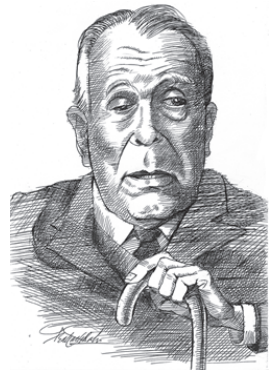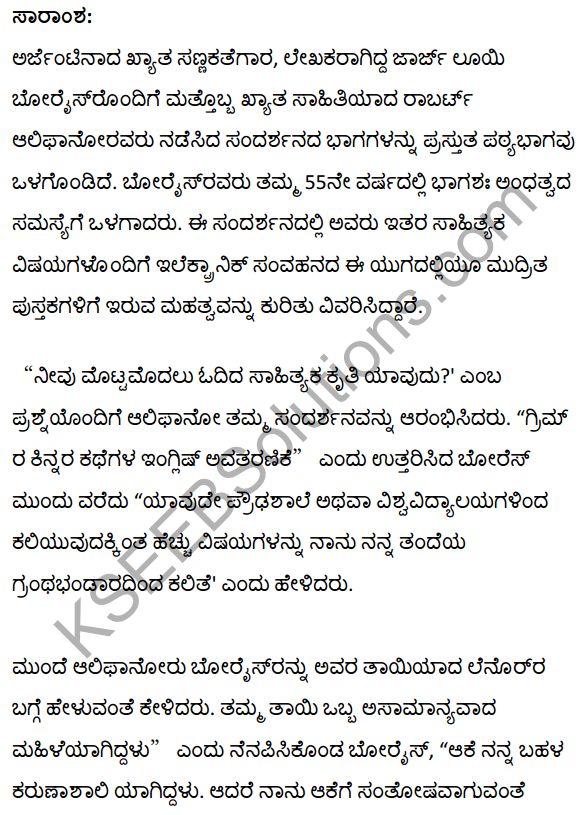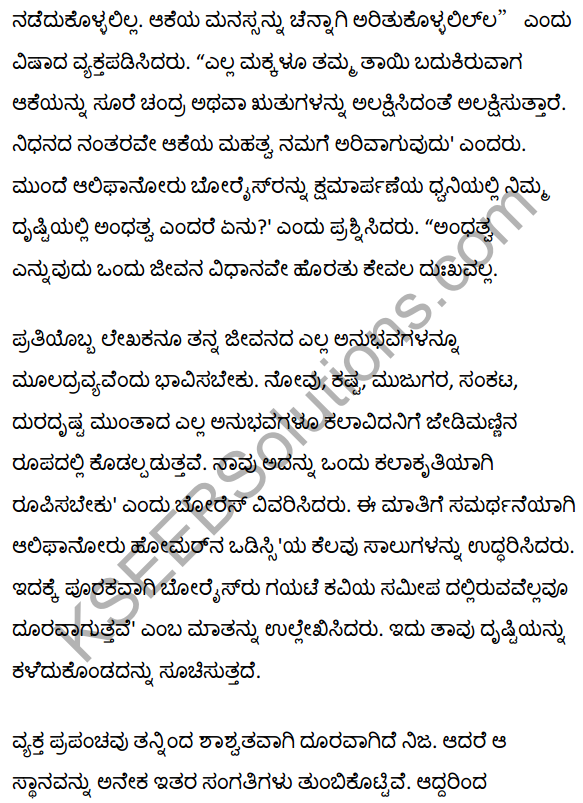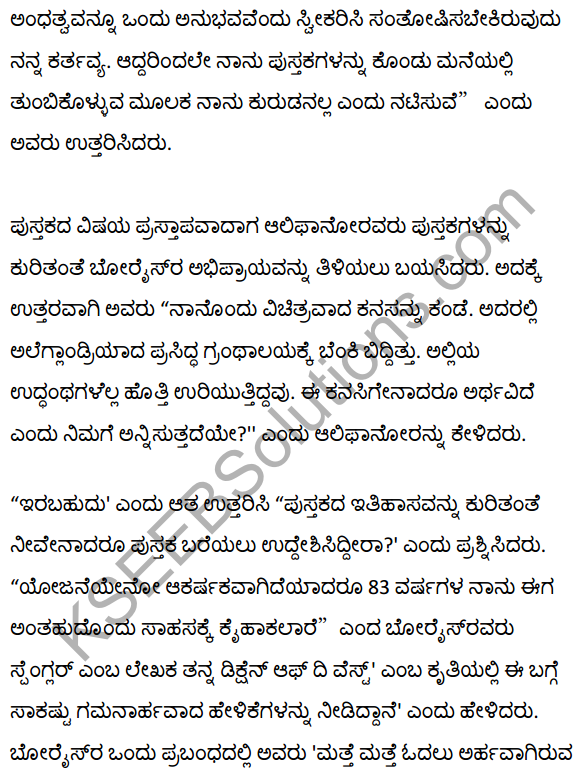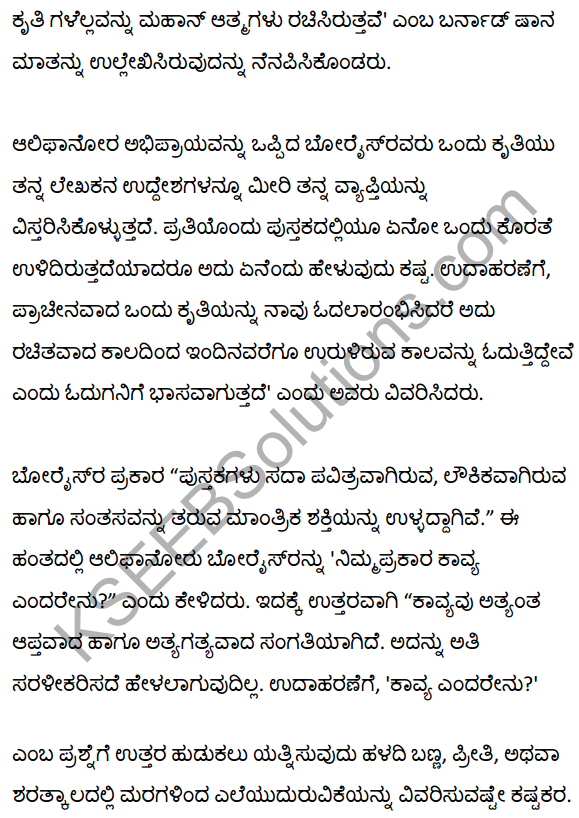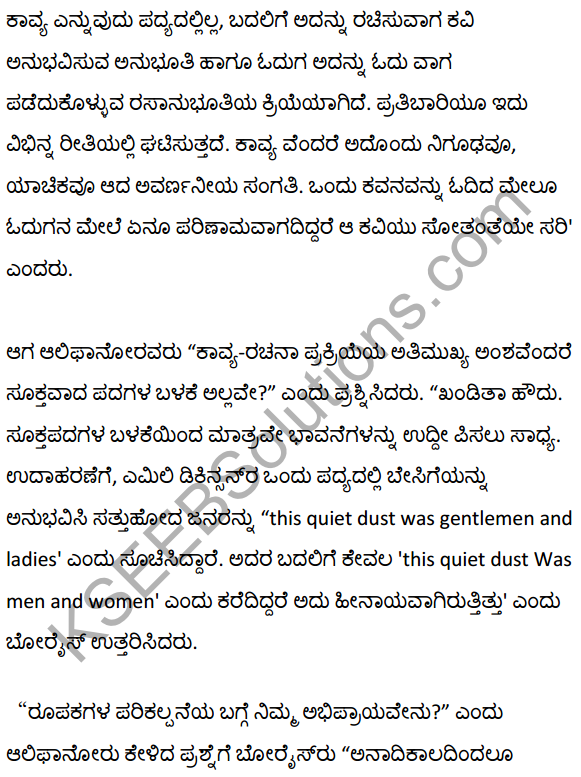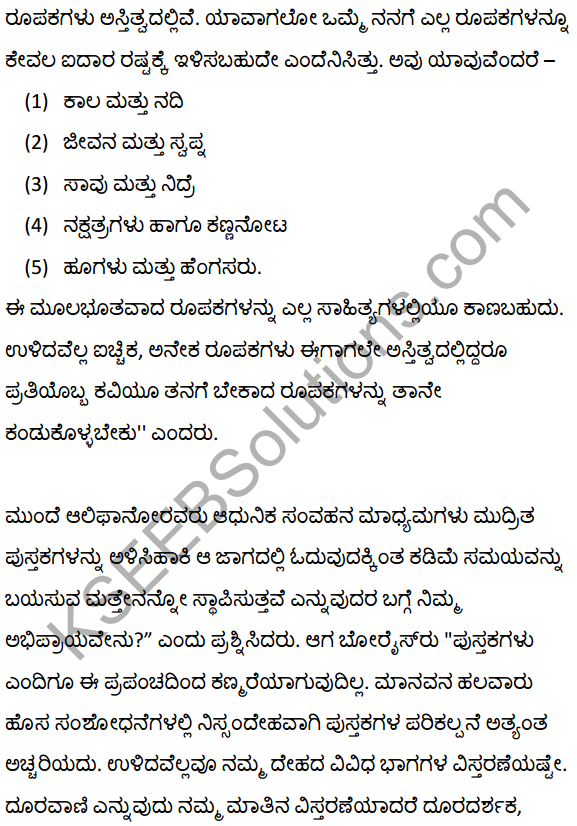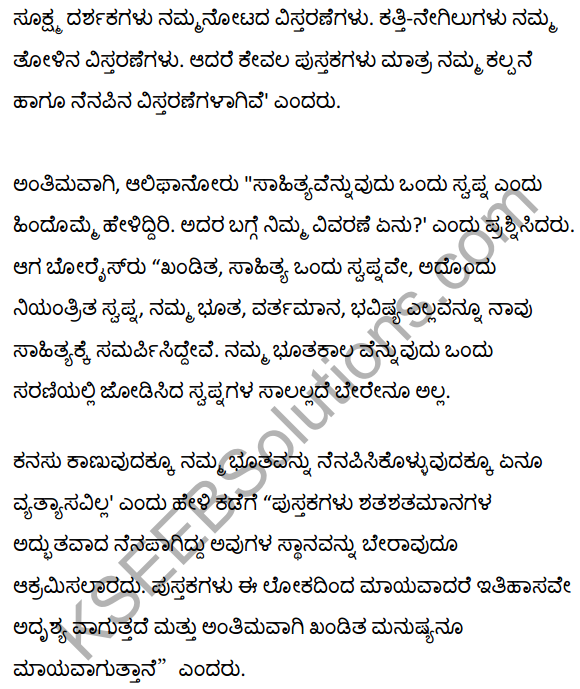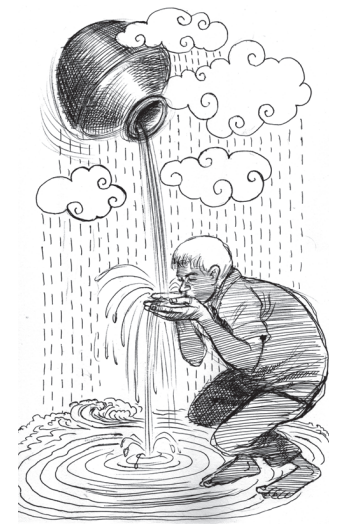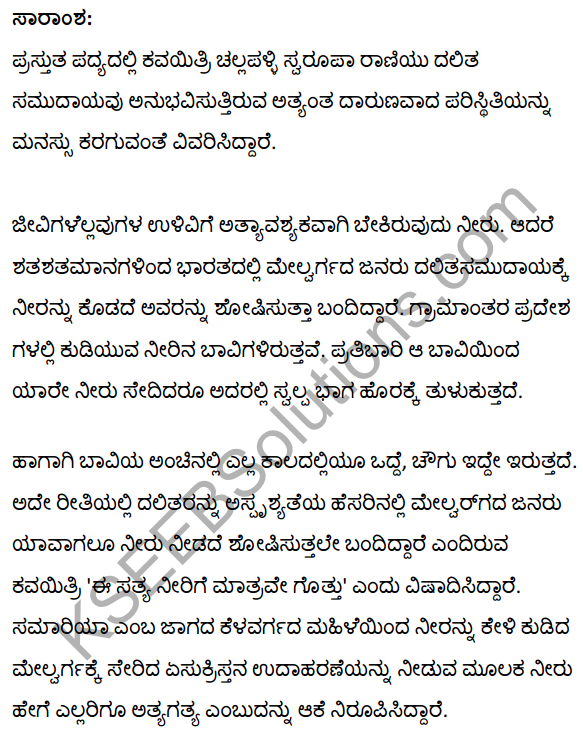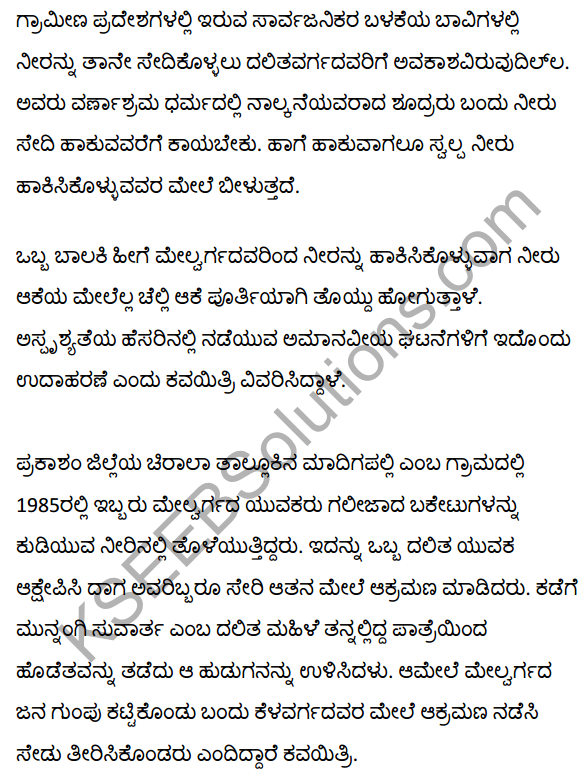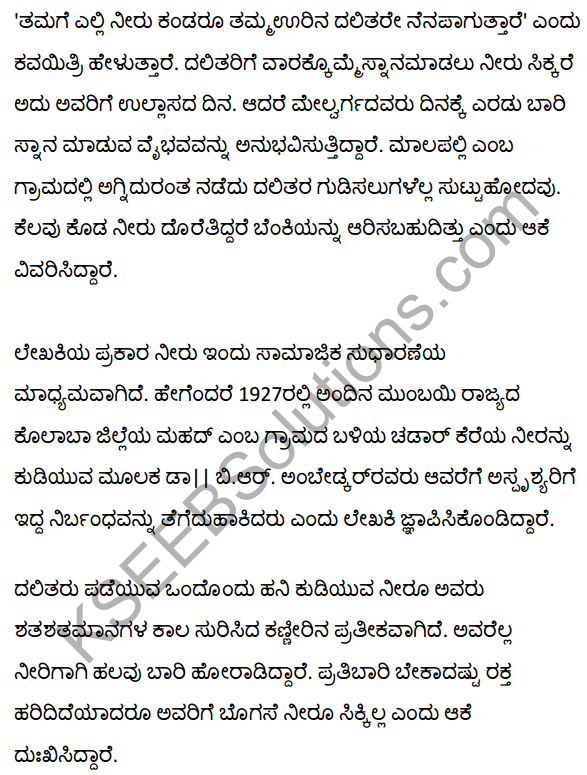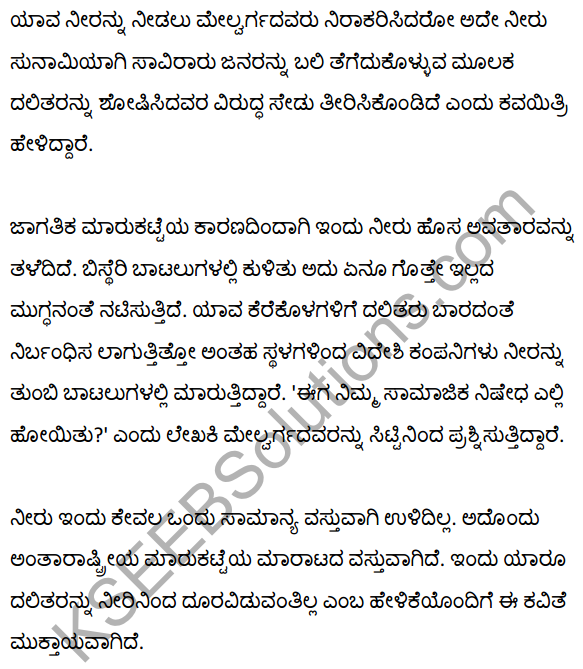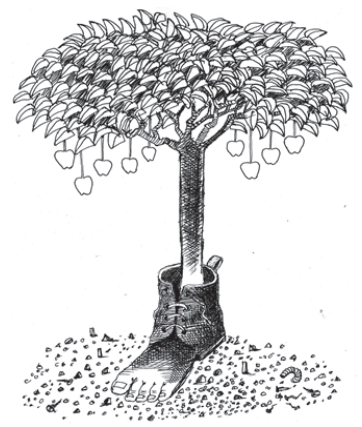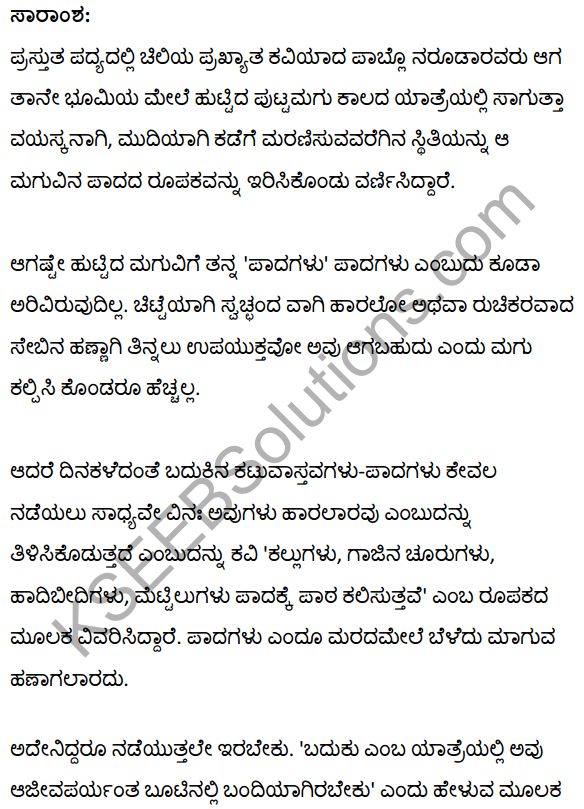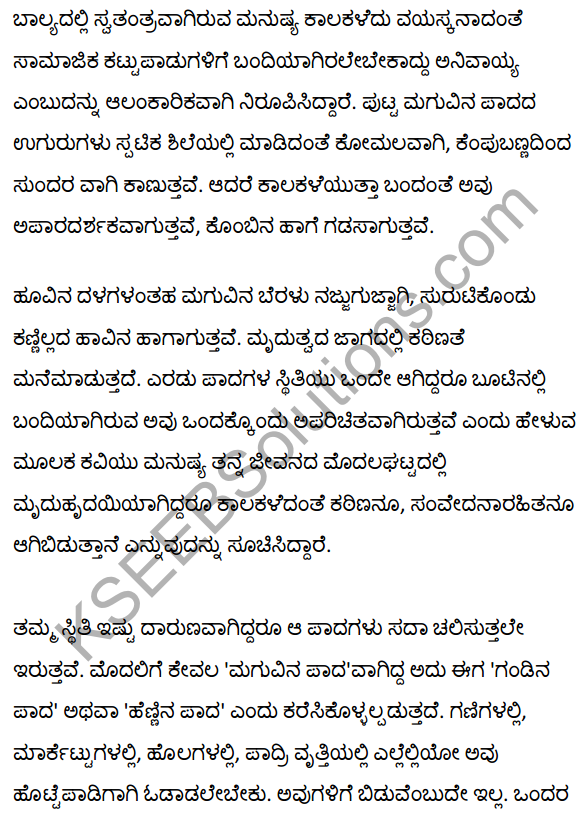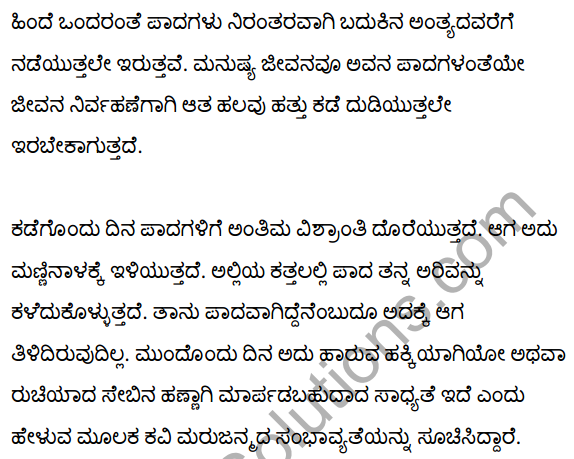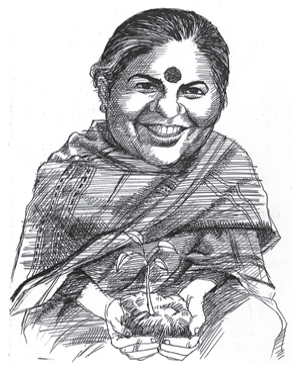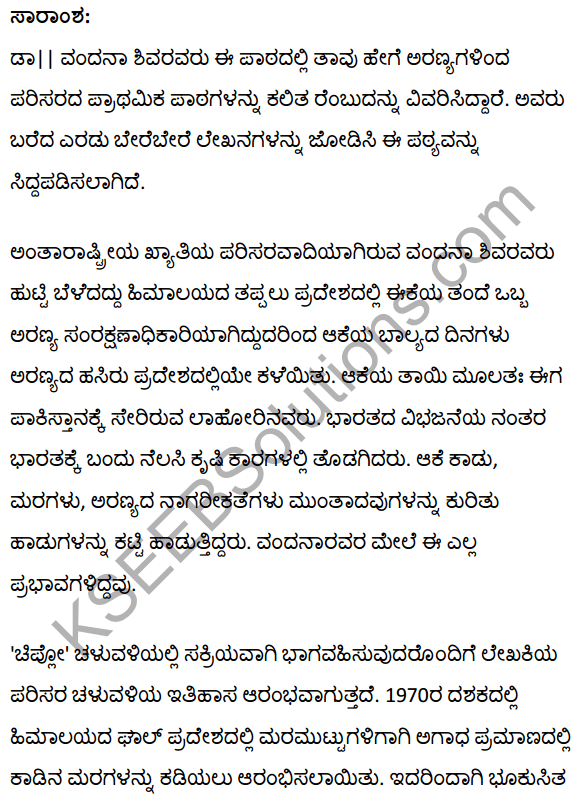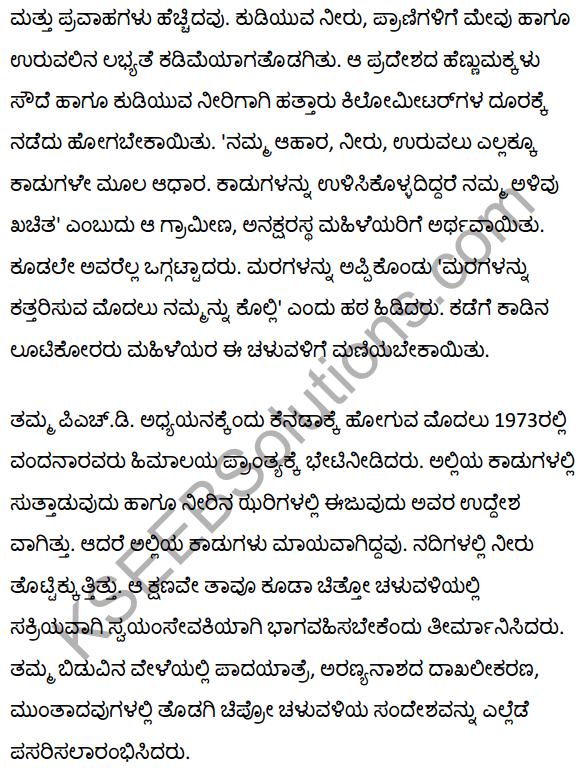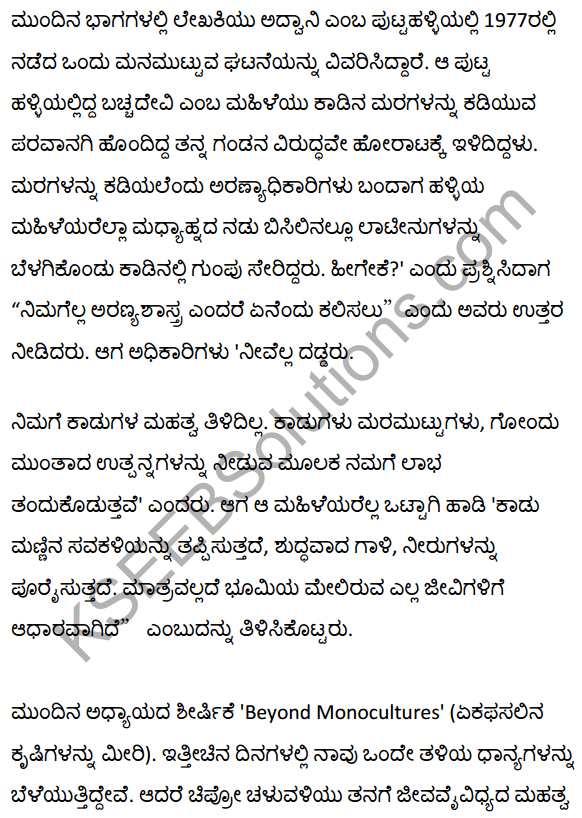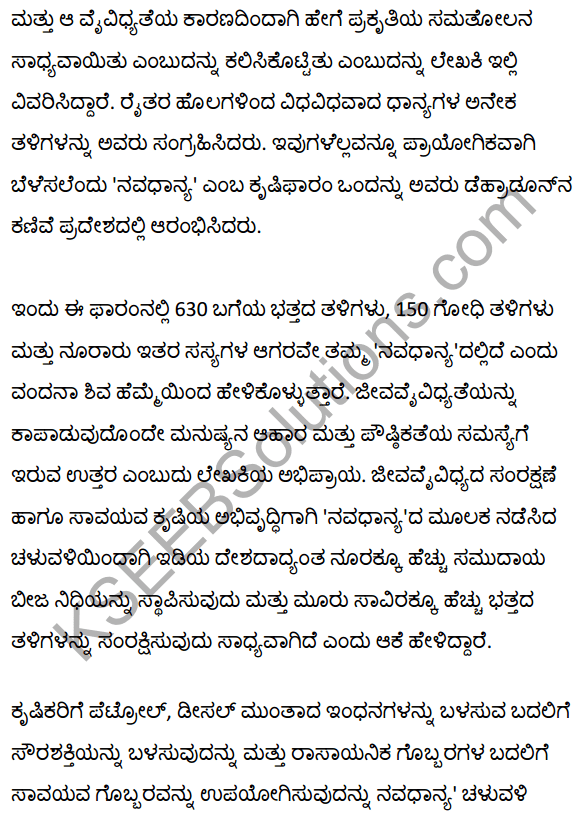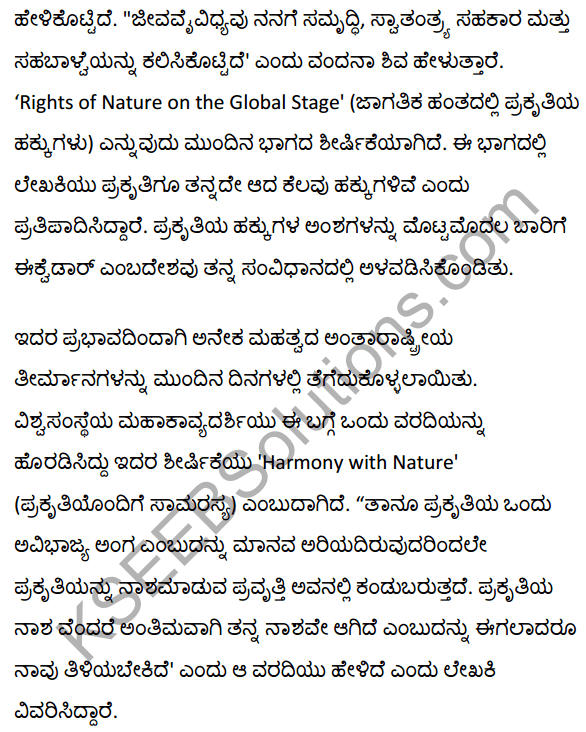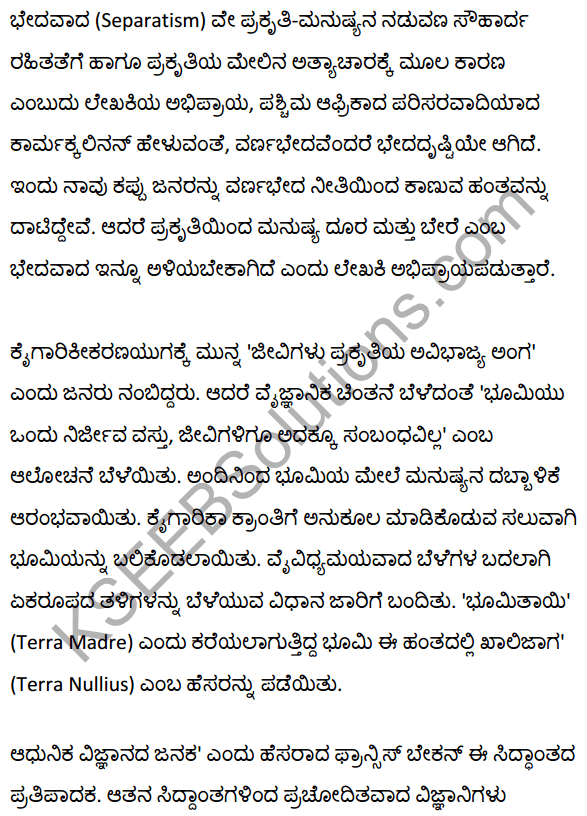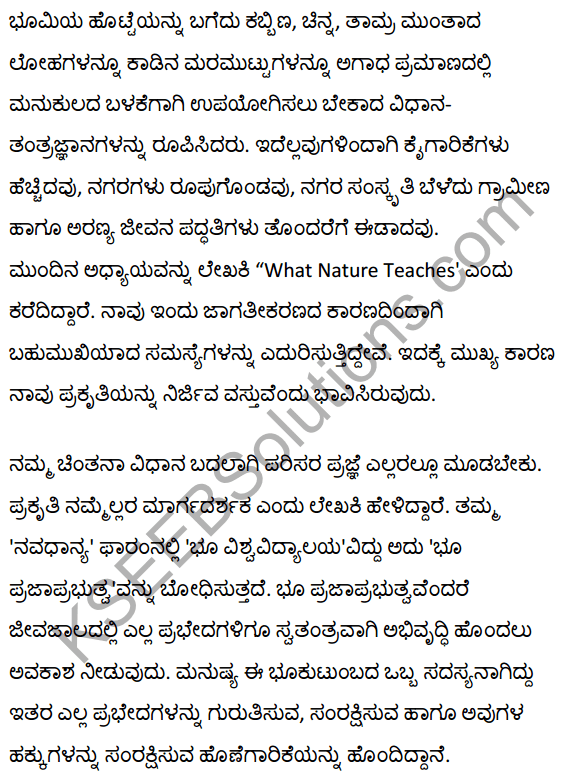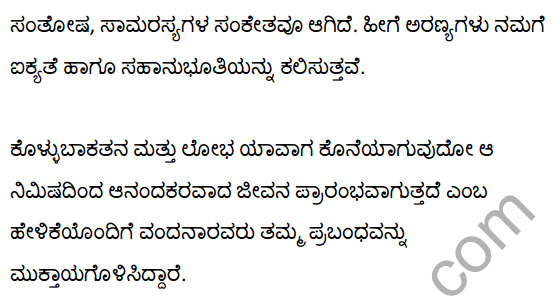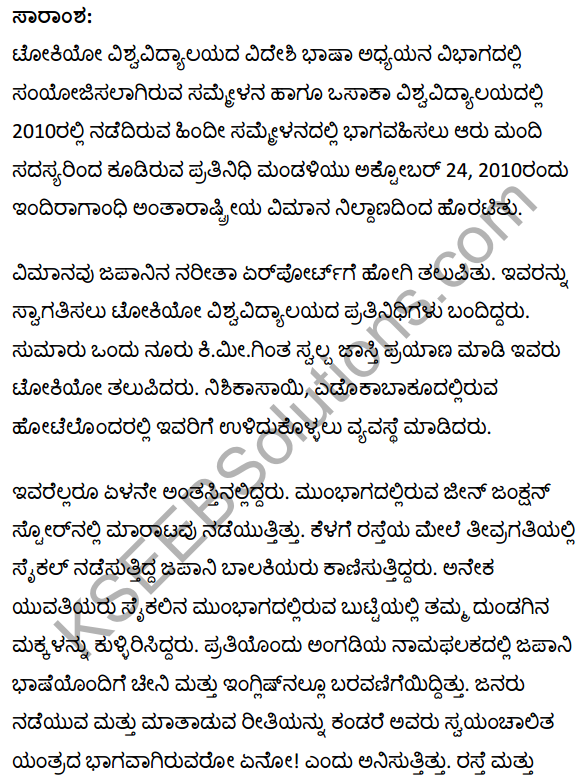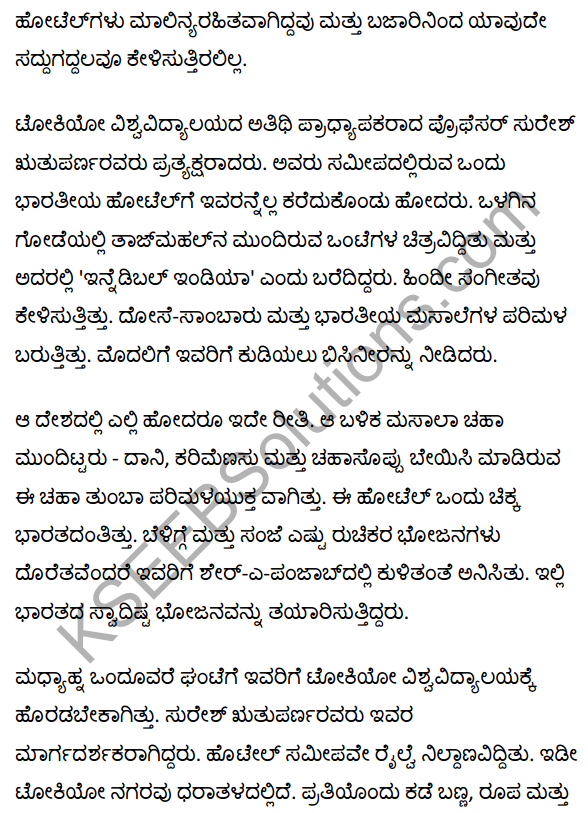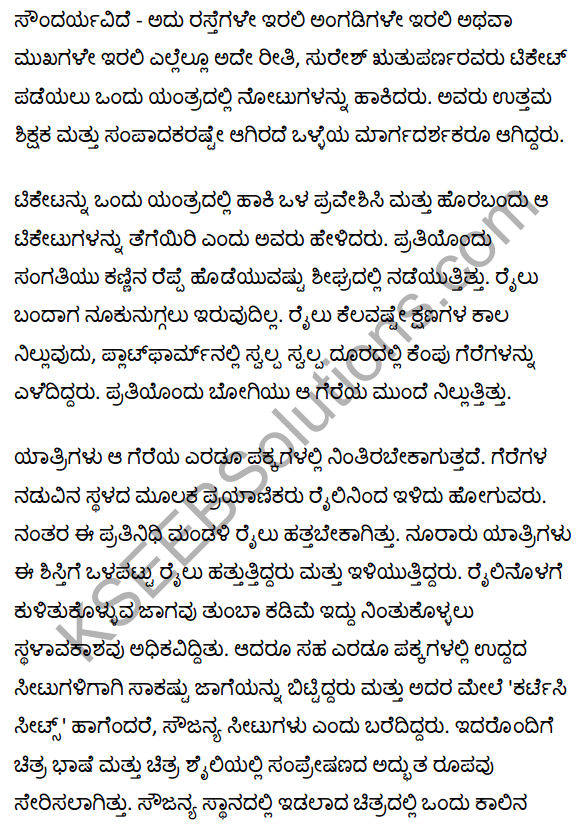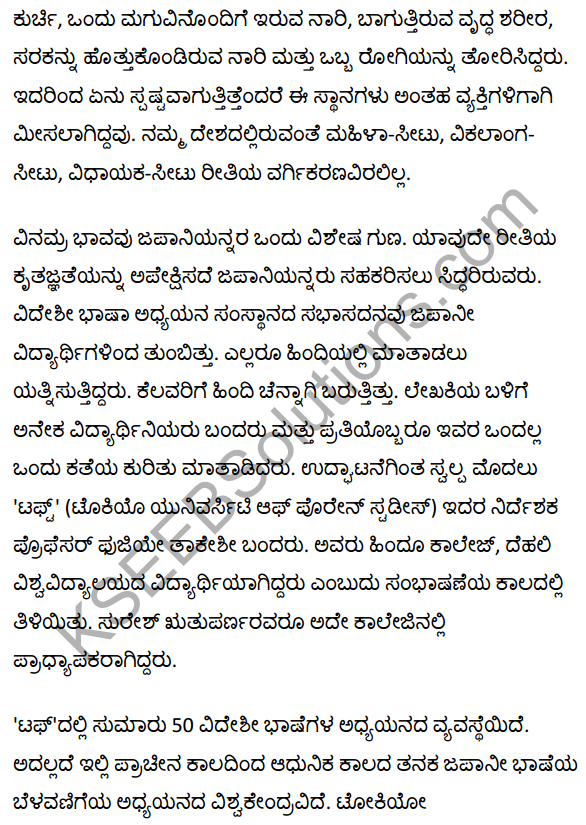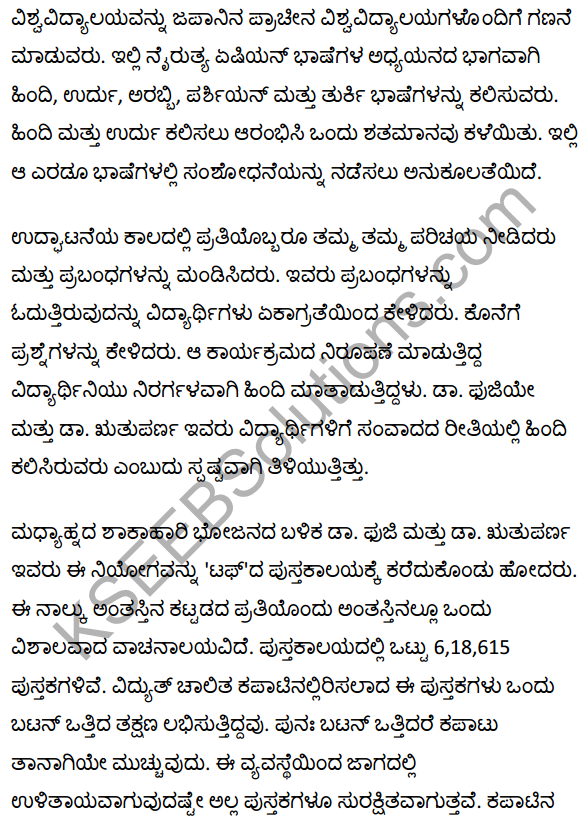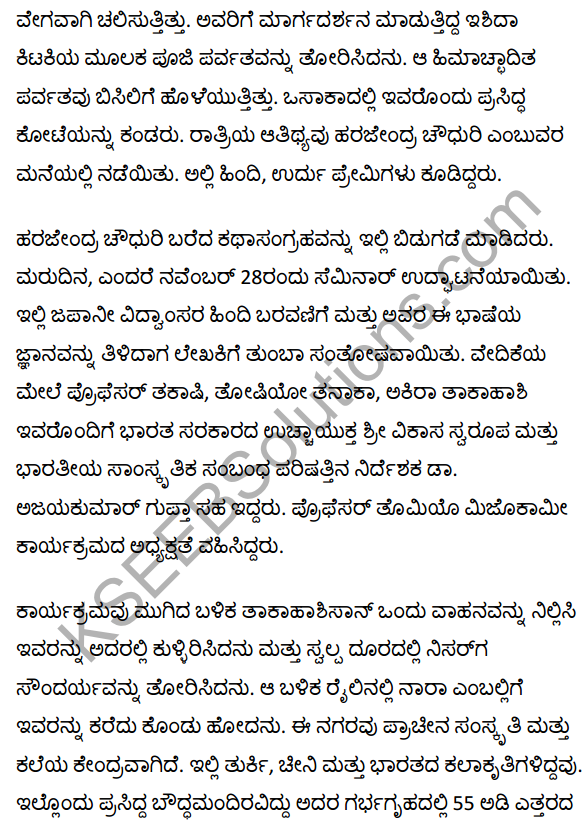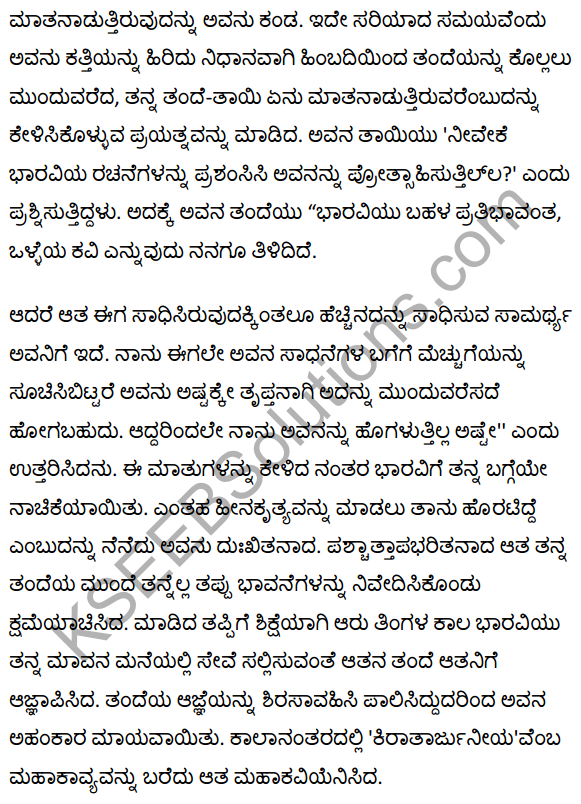Students who are in search of 2nd PUC English Grammar Notes Unseen Passages pdf. First check in which chapter you are lagging and then Download Karnataka Board 2nd PUC English Textbook Answers Chapter Wise. Students can build self confidence by solving the Answers with the help of Karnataka State Board 2nd PUC. English is the scoring subject if you improve your grammar skills. Because most of the students will lose marks by writing grammar mistakes. So, we suggest you to Download Karnataka State Board 2nd PUC English Answers according to the chapters.
Karnataka 2nd PUC English Grammar Notes Unseen Passages
1. Read the following passage and answer the questions set on it.
Over a hundred years ago, the carrying of mail was a hazardous venture; and the mail runner or ‘hirkara’ as he was called, had to be armed with a sword or spear. That was before railways and air services made the delivery of mail a routine affair. Though the first public postal service was introduced in India by Warren Hastings in 1774, the kings and emperors of India had always maintained their own personal postal system. Their rule was effective partly due to excellent means of communication by which dispatches were passed on from hand to hand either by runners or horsemen. When Ibn Batuta was travelling in India, in the middle of the 14th century, he found an organised system of couriers established throughout the country by Mohammed Bin Tughlak.
“There is a foot courier at a distance of every mile”, wrote Ibn Batuta, “and at every three miles there is an inhabited village, and outside it three sentry boxes, where the couriers sit. In the hands of each is a whip about two cubits long, and upon the head of this are small bells. Whenever one of the couriers leaves any city, he takes his dispatches in one hand and the whip, which he keeps constantly shaking, in the other. In this manner he proceeds to the nearest foot-courier and as he approaches, shakes his whip, upon this comes another man who takes the dispatches and proceeds to the next. It is for this reason that the Sultan receives his dispatches in so short a time.” This system was of course established for the convenience of the Emperor and was continued with various innovations by successive Moghul emperors in the 18th century. The East India Company established a postal system of its own to facilitate the conveyance of letters between different offices; but it was only during Warren Hastings’ administration that a Post Master General was appointed and the general public could avail of the service, paying a fee on their letter.
Answer the following in a word, a phrase or a sentence each.
(a) What was the mail runner called as?
(b) Who introduced the first postal service in India?
(e) Whom did the kings and emperors prefer to deliver their dispatches?
(d) When did Ibn Batuta travel in India?
(e) What did Mohammed Bin Tughlak establish?
(f) Where do the couriers sit?
(g) Which word in the passage means ‘new ideas or techniques’?
(h) As the courier approaches the nearest foot-courier near an inhabited village/city he
(i) shouts out loudly.
(ii) shakes the whip.
(iii) whistles and sings.
(i) Kings and emperors would successfully (communication/communicate) with each other through couriers.
(j) When was the Post Master General appointed?
Answers:
(a) The mail runner was called ‘Hirkara.
(b) Warren Hastings introduced the first postal service in India.
(c) The kings and emperors preferred their dispatches to be passed on from hand to hand either by runners or horsemen.
(d) Ibn Batuta travelled in India in the middle of the 14th century.
(e) Mohammed Bin Tughlaq established an organised system of couriers.
(f) The couriers sit in three sentry boxes outside every inhabited village.
(g) Innovations.
(h) – (ii) shakes the whip.
(i) Communicate.
(j) The Post Master General was appointed during the administration of Warren Hastings.
2. Read the following passage and answer the questions set on it.
A ten-year-old boy saw a flying bird and shot it down. He ran and picked it up. The bird looked like a house sparrow, but it had a yellow patch on the throat. The child had not seen such spots before. The puzzled boy took the sparrow to his uncle Amiruddeen and asked him what kind of bird it was. His uncle was not able to satisfy his curiosity. He took the boy to the office of Bombay Natural History Society and introduced him to W.S. Millard, the Honorary Secretary of the Society.
Millard was surprised to find such a young boy keen to know about the bird. He took him around the room and showed him many stuffed birds. The child became more curious about birds.
Thereafter, the boy started coming to his office frequently to learn about identifying and preserving birds. The boy was Salim Moizuddin Abdul Ali, later known as Salim Ali, the bird watcher. Salim Ali was born on November 12,1896. He did a course in Zoology and was appointed a guide at the museum of Bombay Natural History Society. During the course of this work he became more and more eager to study the living conditions of the birds. With this aim he went to Germany. After one year, he returned to India. In his absence, his post in the museum had been abolished for lack of funds.
He would sit under the trees throughout the day and write in his note book about the activities of the weaver bird. In 1930 he published a research paper on the nature and the activities of the weaver bird. The published papers brought him fame and recognition in the fields of Ornithology. After this, he travelled to various places to study about birds and wrote a book titled ‘The Book of Indian Birds’ which was published in 1941. The book gave information about 538 species of Indian birds.
Because of his deep knowledge about birds, people started calling him the moving encyclopaedia of birds. He worked not only in the study of birds but also in the field of protection of nature. He was given an International award of Rs. 5,00,000 which he donated to the Bombay Natural History Society. In 1983, he was awarded the Padma Vibhushan by the Government of India.
When this ninety-year-old ornithologist died oh 20 June 1987, the birds lost their godfather and friend.
Answer the following in a word, a phrase or a sentence each.
(a) Which bird had the boy shot down?
(b) What difference did the boy see about the bird?
(c) Name the boy’s uncle.
(d) Who was W.S. Millard?
(e) Where was Salim appointed as a guide?
(f) How long had Salim been in Germany?
(g) Salim was famous for his role in the (protecting/protection) of nature.
(h) Mention the title of the book written by Salim.
(i) Pick out and write the word which means ‘Study of Birds’ in the passage.
(j) Which award was conferred on Salim Ali by the Government of India?
Answers:
(a) The boy had shot down a flying bird with a yellow patch on the throat which looked like a house sparrow.
(b) The bird had a yellow patch on the throat.
(c) Amiruddeen.
(d) W. S. Millard was the Honorary Secretary of the Bombay Natural History Society.
(e) Salim was appointed as guide at the museum of Bombay Natural History Society.
(f) Salim had been to Germany for one year.
(g) Protection.
(h) The Book of Indian Birds.
(i) Ornithology.
(j) Padma Vibhushan was conferred on Salim Ali by the Government of India.
3. Read the following passage and answer the questions set on it.
A remarkable story of personal survival ever published was that of an American Corps pilot named Lieutenant Colonel William Rankin. It was on 26th July, 1959, that colonel Rankin was flying at an altitude of 47,000 feet over South Carolina, when the red fire-warning light flashed on in the cock pit of his crusader jet fighter plane. At the same time he felt jerking and shaking. After communication with a companion aircraft on his radio, Colonel Rankin decided to make an emergency exit from his falling plane by using the ejection seat.
It is all the more of interest and essential to point out that up to that moment, nobody had ever ejected from a plane flying at 500 miles per hour and at such an altitude. Outside the protection of his pressurised cockpit, the pilot had to face an air temperature of 70 degrees below zero, and a low atmospheric pressure which was liable to make his blood boil especially when he was wearing only flying suit, helmet, gloves and ordinary footwear. His parachute was designed to open automatically at 10,000 feet but as he glanced below, the colonel saw to his horror that he was falling straight into the centre of a huge, black thunder cloud. Powerless to do anything he gritted his teeth and awaited the sudden jerk of his opening parachute. As its reassuring canopy blossomed out above him, he felt another tremendous blast as the terrible forces of wind and hail inside the thunder cloud battered his body.
Instead of descending at a normal rate of about 1,000 feet per minute, a powerful up current of air sent him up, until he was floating on the clouds which enclosed him from all directions. Suddenly there was thunder and lightning. The next instant, he would again be flying upwards until his shoulders ached with the drag. Every second he feared his parachute would tear into pieces.
After tearing winds and crashing sounds, the Colonel gradually felt the turbulence lessening. Then, at last he caught a glimpse of green field below him. He had finally emerged from the giant thunder cloud which had held him prisoner for over half an hour. In fact, his descent, which would normally have lasted ten minutes, had taken forty minutes.
Answer the following in a word, a phrase or a sentence each.
(a) When did the incident mentioned in the passage take place?
(b) Where was Colonel Rankin flying over at the time of the accident?
(c) What warned Rankin about the calamity?
(d) Mention any one of the problems faced by him when he ejected out of the cockpit.
(e) Where did the colonel land straight into?
(f) What battered his body inside the thunder cloud?
(g) Add suffix to the word ‘power’ to make its antonym.
(h) He caught a glimpse of green field below. Here the word ‘glimpse’ means
(i) caught sight of (ii) couldn’t see anything (iii) saw far of fire.
(i) How long was Rankin enclosed in the thunder cloud?
(j) The Colonel ‘gritted his teeth’. The idiomatic expression means
(i) to be afraid (ii) to be cold (iii) to be angry.
Answers:
(a) The incident mentioned in the passage took place on 26 July 1959.
(b) At the time of the accident, Colonel Rankin was flying at an altitude of 47,000 feet over South Carolina.
(c) The red fire-warning light flashed on in the cockpit of Colonel Rankin’s crusader jet fighter plane which warned him about the calamity.
(d) When the pilot ejected out of the protection of his pressurised cockpit, he had to face an air temperature of 70 degrees below zero, and a low atmospheric pressure which was liable to make his blood boil especially when he was wearing only flying suit, helmet, gloves and ordinary footwear.
(e) The colonel landed straight into the centre of a huge, black thunder cloud.
(f) The terrible forces of wind and hail inside the thunder cloud battered the colonel’s body.
(g) Powerless.
(h) – (i) caught sight of.
(i) Colonel Rankin was enclosed in the thunder cloud for over half an hour.
(j) – (ii) to be cold.
4. Read the following passage and answer the questions set on it.
George Bernard Shaw, one of the greatest playwrights of all time, was born in Dublin on 26th July, 1856. As a young man he was terribly shy and to hide his shyness he developed a very gruff manner and voice which some people mistook as rudeness. However, his close friends understood him better as he was the very essence of kindness to those whom he loved and associated with.
At the early age of fourteen, he obtained employment as a junior clerk and though he was quite good at his work, he hated it. So he quit his job and went to London in search of other employment. Before long a newspaper office hired him and he took up employment as critic of books, music and plays. His duty was to attend the various plays staged and give his opinion on them for publication. It was then that he decided to write his own plays. The plays he wrote and produced were a tremendous success. In no time he became world famous as a playwright. Many film companies approached him to use his plays for making movies, but he never liked the idea and turned them down. Finally, he consented to allow his play ‘Pygmalion’ to be made into a film. This play depicts the story of a little flower girl, T chneb’-Dy an’Lnghsn professor to speak proper “English. In fact, the professor succeeded in transforming her from an uneducated flower girl into a refined lady. Years later, this play was made into a musical hit – the legendary, ‘My Fair Lady’. And it became a worldwide success. Shaw used the huge money earned from this, to worthy causes, such as the enlargement of National Gallery of Ireland, the Royal Academy of Dramatic Art and the British museum. The film ‘My Fair Lady’ is about how complicated English language is and the difficulties faced by Eliza, the flower girl, to learn and master this language.
He lived long enough to see people all over the world enjoy his plays. He died at the ripe old age of ninety-four.
Answer the following in a word, a phrase or a sentence each.
(a) How did Bernard Shaw try to hide his shyness?
(b) How old was Bernard Shaw when he took up his first job?
(c) Where did Bernard Shaw go after quitting his job?
(d) Which of his plays was made into a film first?
(e) Name the little flower girl who appears in the musical hit ‘My Fair Lady’.
(f) Add suitable prefix to the word ‘educated’ to form its antonym.
(g) Mention any one of the causes to which Shaw contributed the money earned by him.
(h) Who trained the flower girl to become a refined lady?
(i) How old was Shaw when he died?
(j) English language is full of (complication/complications).
Answers:
(a) To hide his shyness, Bernard Shaw developed a very gruff manner and voice which some people mistook for rudeness.
(b) Bernard Shaw was fourteen years old when he took up his first job.
(c) Bernard Shaw went to London after quitting his job.
(d) ‘Pygmalion’ was the first of his plays to be made into a film.
(e) Eliza.
(f) Uneducated.
(g) Enlargement of the National Gallery of Ireland.
(h) An English professor trained the flower girl to become a refined lady.
(i) Shaw was ninety-four years old when he died.
(j) Complications.
5. Read the following passage and answer the questions set on it.
If you visit the three pyramids of Giza, you will be surprised to see a colossal statue of a beast with a man’s head and a lion’s body. This is the great Sphinx that sits in the desert of Egypt, about 12 kms from Cairo. The statue has mysterious eyes and an enigmatic expression. It gazes over the desert with a kind of mystical superiority. It is one of the most historical monuments in the world.
The Sphinx was carved out of the hill rock leftover from the building of the Great Pyramid. It is about 20 m in height and 70 m in length. According to popular belief, it was made some 5000 years ago to resemble the face of Chephren, a king of the fourth dynasty. It was built during the reign of the Egyptian king Khafre.
Why was the Sphinx built? The Sphinx was a mystical monster. The Greeks thought of it as having the head of a woman, and body of a lion with wings. The Egyptians thought of ft as a wingless lion with the head and breast of a man. It was believed that the Sphinx would ward off all evils from the cemetery around the pyramids.
Apart from the great Sphinx of Giza, there are many other Sphinxes in Egypt. Their heads represent different kings. In ancient Egypt, kings were considered to be descendants of the Sun God called Rio. When a king died, he himself was supposed to become the Sun God. Kings were also believed to have the strength of various beasts. So the Egyptians sculpted their Gods and kings in the shape of half human and half beast.
There is another Sphinx with a female face. It is made after the queen of Hatshepsut, who had seized the throne and ruled the country. This Sphinx has a beard which represents queen Hatshepsut’s masculine powers.
Answer the following in a word, a phrase or a sentence each.
(a) Where can one come across the Sphinx?
(b) What expression is seen on the face of Sphinx of Giza?
(c) Which leftover rock was used to carve the Sphinx?
(d) Whose face does the Sphinx of Giza resemble?
(e) Name the Sun God of Egypt mentioned in the passage.
(f) Add suitable prefix to the word ‘Popular’ to make its antonym.
(g) Whose face does the Sphinx with female face resemble?
(h) The Egyptians (believe/belief) that Sphinxes have mystical powers.
(i) Why is there a beard on the face of the female Sphinx?
(j) In what form were the Gods and kings in Egypt sculptured?
Answers:
(a) One can come across the Sphinx in the desert of Egypt, about 12 kms. from Cairo.
(b) An enigmatic expression is seen on the face of the Sphinx of Giza.
(c) The Sphinx was carved out of the hill rock leftover from the building of the Great Pyramid.
(d) The Sphinx of Giza resembles the face of Chephren, a king of the fourth dynasty.
(e) Rio.
(f) Unpopular.
(g) The Sphinx with the female face resembles the queen of Hatshepsut.
(h) Believe.
(i) The female Sphinx has a beard which represents queen Hatphepsut’s masculine powers.
(j) The Egyptians sculpted their Gods and kings in the shape of half-human and half-beast.
6. Read the following passage and answer the questions set on it.
Confucius was one of the greatest moral teachers and philosophers of China. He studied ancient Chinese writings with great devotion. These works taught him new ideas about character development. His actual name was ‘Kung fu-tzu’, the Catholic missionaries called him Confucius.
Confucius was born in the state of Lu, now part of Shandong in China. His family belonged to the lowest level of aristocracy. His parents died when he was still young and he grew up in poverty. Later, he became an official in the government of Lu, and was much respected.
China, during those days, was ruled by an emperor with very little powers. The provinces were controlled by corrupt and greedy feudal lords. The people were poor and neglected. Confucius felt disgusted at this state of affairs and left Lu in 484 BC. He started preaching whatever he had learnt from the ancient Chinese writings. Human behaviour, morality and politics were the main elements of his teaching. At the age of twenty-two he started teaching how to lead a happy life. He said, ‘Don’t do to others what you would not wish them to do to you’. He taught, ‘Thou shall love thy neighbour as thyself’. He was very modest and always said, ‘1 teach nothing new. I only pass on the ancient wisdom’.
On returning to Lu, he also held some important positions in the local government of his province. When he was made the Governor of a city, he cleared the state of robbers, reduced taxes, improved people’s living conditions and persuaded the ruling classes to lead charitable lives. According to one account, he was also made a minister. He tried his best to improve the evils ingrained in all branches of social life. But soon he realized that they were deep-rooted. So he resigned in disgust at the age of 54.
Confucius’ own sayings were collected by his disciples and written down much later, in the book ‘Lun Yu’. Confucius died in 479 BC. The religion founded by him is known as Confucianism. It includes ancestor worship, belief in supreme God and belief in Nature Spirit. Even today it influences millions of lives.
Answer the following in a word, a phrase or a sentence each.
(a) Which country did Confucius come from?
(b) Who named him Confucius?
(c) For which government did he work as official?
(d) By whom were the provinces in China controlled?
(e) What did he do after leaving Lu?
(f) Mention any one of the elements of his teaching.
(g) How old was he when he started teaching?
(h) Add a prefix to the word ‘morality’ to form its antonym.
(i) Confucius was very (wise/wisdom) in his thinking.
(j) Name the book written by his disciples about the sayings of Confucius.
Answers:
(a) Confucius came from the state of Lu, now part of Shandong in China.
(b) The Catholic missionaries called him Confucius.
(c) Confucius worked as an official in the government of Lu.
(d) The provinces in China were controlled by corrupt and greedy feudal lords.
(e) Confucius started preaching whatever he had learnt from the ancient Chinese writings after leaving Lu.
(f) Human behaviour.
(g) Confucius started teaching at the age of twenty-two.
(h) Immorality.
(i) Wise.
(j) ‘Lun Yu’
7. Read the following passage and answer the questions set on it.
Long before there were restaurants, there were taverns where people gathered to talk, have something to drink and perhaps something to eat.
In London there was another kind of place that was also the forerunner of the restaurant. This was the ‘Cook Shop’. The chief business of these Cook Shops was sale of cooked meals on the premises and was somewhat like a restaurant. There were Cook Shops in London as long back as the 12th Century.
The first place where a meal was provided every day at a fixed place was the tavern in England. They often became ‘dining clubs’ and these existed in the 15th Century. By the middle of the 16th Century, many town people of all classes had got into the habit of dining out in the taverns. Most of the taverns offered a good meal for a shilling or less, with wine and ale as extras. Many taverns became meeting places of the leading people of the day. Shakespeare used to be a regular customer of the Mermaid tavern in London.
About 1650, coffee-houses also sprang up in England. They served coffee and tea and chocolate, which were all new drinks at that time. Sometimes they served meals too. In 1765, a man named Boulanger opened a place in Paris which served meals and light refreshments, and he called his place a ‘restaurant’. This was the first time this word was used. It was a great success and many other places like it soon opened.
In a short time, all over France, there were similar eating places called restaurants. But the word ‘restaurant’ was not used till the end of the 19th Century.
In the United States, the first restaurant of which there are records was the Blue Anchor Tavern in Philadelphia which opened in 1683.
Answer the following in a word, a phrase or a sentence each.
(a) Where did people gather to drink before restaurants came into existence?
(b) What did the Cook Shops sell?
(c) When did dining places come into existence?
(d) Which tavern did Shakespeare often visit?
(e) When did coffee-houses come into existence in England?
(f) Pick out the word which means ‘identical’ in the passage and write it.
(g) J/Vho introduced the word ‘restaurant’ for the first time?
(h) Use the appropriate prefix to the word ‘regular’, to form its antonym.
(i) Blue Anchor Tavern is in
(a) Paris. (b) Philadelphia. (c) France.
(j) Restaurants became in the 20th Century, (successful/success)
Answers:
(a) Before restaurants came into existence, people gathered at taverns to drink.
(b) Cook shops sold cooked meals.
(c) Dining places came into existence in the 15th century.
(d) Shakespeare used to be a regular customer of the Mermaid tavern in London.
(e) Coffee-houses came into existence in England in the year 1650.
(f) Similar
(g) A man named Boulanger introduced the word ‘restaurant’ for the first time.
(h) Irregular
(i) b) Philadelphia
(j) successful
8. Read the following passage and answer the questions set on it.
Newspaper starts the day for many of us. To begin with, the members of the newspaper staff make plans for the contents of the next edition of the newspaper during their daily or weekly editorial meetings. They discuss upcoming news events and work out ideas for fresh stories. The editor then assigns stories for journalists and photographers to work on and complete within the specified deadlines.
Journalists then carry out research to gather all the facts that relate to the story they have been assigned. Besides collecting information from books, magazines, other newspapers and the ‘internet’, journalists also conduct interviews with people involved in the issue.
Photographers are allocated stories for which they need to take photos that suit the style of the story. Sometimes, the editor or journalist selects suitable photos from the newspaper archives. The writing of the story begins when the journalists have completed all their research. The journalists type out their stories or articles on the computer. They must ascertain that their facts are accurate, and they must write in clear and concise style.
The journalist’s story reaches the editor via newspaper’s computer system and he or she decides whether the angle of the story is correct and whether the story is newsworthy. Once the story is approved by the editor, it goes to the copy desk. A copy editor checks the story for grammatical errors and misspellings, and makes the story easier to read. The copy editor looks for “holes” or gaps in the story that might leave readers with too many unanswered questions and cause miscommunication. If the story or article is too long, it is edited down to the right size and also added is an eye-catching headline.
Editors also choose photos and decide on illustrations to read with the story. Graphic artists are responsible for creating charts and illustrations that certain articles need.
The articles, photographs and advertisements are laid out on each page of the newspaper. Page layouts are done by computer using special software for designing pages.
The finished layout of the newspaper is transferred electronically from computers to the printing press. The entire paper is printed, folded and put together. After printing, the newspapers are bundled into groups, loaded into trucks and sent out to be delivered.
Answer the following in a word, a phrase or a sentence each.
(a) What starts the day for many of us?
(b) Who makes plans for the contents of the next edition?
(c) Mention any one of the sources from which a journalist gathers facts related to the story.
(d) Where are suitable photos selected sometimes to suit the style of the story from?
(e) When does the writing of the story begin?
(f) Where is the approved story sent to?
(g) Add suitable prefix to the word ‘communication’ to form its antonym.
(h) What decides the choice of the photos?
(i) What purpose is special software used for?
(j) A newspaper article should be free of (grammar/grammatical) errors.
Answers:
(a) Newspaper starts the day for many of us.
(b) The members of the newspaper staff make plans for the contents of the next edition.
(c) Books.
(d) Suitable photos are sometimes selected from the newspaper archives or from photographers who are asked to take photos for allocated stories to suit the style of the story.
(e) The writing of the story begins when the journalists have completed all their research.
(f) The approved story is sent to the copy desk.
(g) Miscommunication.
(h) The editors choose the photos and decide on illustrations to read with the story.
(i) The special software is used for designing the pages of the newspaper.
(j) Grammatical.
9. Read the following passage and answer the questions set on it.
Amelia Earhart was a famous American aviation pioneer who set record after record during her flying carrier. She mysteriously disappeared while attempting a record breaking flight around the world.
In 1928 she achieved worldwide fame when she became the first woman to cross the Atlantic Ocean as a passenger on a plane piloted by Wilmer Stultz. Then in 1932 she became the first woman and the second person to fly solo non-stop across the Atlantic. Although she was by then the undisputed queen of the air, Amelia wanted to achieve more.
In March 1937, she flew to Hawaii intending to circle the globe with fellow pilot, Paul Mantz. Due to fire at take off, the plane ground-looped. In June, she made her second attempt at a round-the-world flight, this time with Fred Noonan as her navigator. At that time, she left behind important communication and navigation instruments, perhaps to make room for additional fuel for the long flight. They departed Miami on June 1, and made it to New Guinea in 21 days.
To begin the next leg of the trip, they departed New Guinea for Howland Island on July 2, 1937. On Howland Island a runway had been hastily built just for Amelia because she needed a place to land and refuel. Only two miles long and a half mile wide Howland Island sits in the middle of the Pacific Ocean. It was such a tiny Island that only the most highly skilled fliers could spot it from up in the air. Therefore, the U.S. Coast Guard Cutter (USCGC) Itasca was designated to communicate with Amelia’s plane and guide her to the Island. At dawn, the ship’s boilers were belching out thick black clouds of smoke as visual signal to Amelia’s plane just in case it arrived early. Meanwhile the ship’s radio stood ready to send and receive messages. Amelia and Noonan had little practical knowledge of the use of radio navigation and the crew at Itasca weren’t able to pick up the radio frequency Amelia was broadcasting. After six hours of confusion, all contact was lost between Amelia and Itasca.
The U.S. navy led a massive search for Amelia and Noonan. Finally, President Roosevelt issued an order for all search attempts to be terminated in 1937. No one knows for sure what happened to Amelia and Noonan. Some believe she was captured by enemies.
Answer the following in a word, a phrase or a sentence each.
(a) What was Amelia’s achievement that made her become famous worldwide?
(b) Name the pilot who flew Amelia’s plane across the Atlantic Ocean.
(c) When did Amelia fly with Paul Mantz to Hawaii?
(d) What did Amelia leave behind during her second attempt at a round-the-world flight?
(e) How long did the flight take to reach New Guinea?
(f) How wide is Howland island?
(g) Pick out the word from the passage that means ‘tool’ or ‘device’.
(h) Mention the mode of visual signal that was planned in case Amelia’s plane arrived early.
(i) Add a prefix to the word ‘disputed’ to form its antonym.
(j) Who issued an order for terminating the search for Amelia and Noonan?
Answers:
(a) Amelia achieved worldwide fame when she became the first woman to cross the Atlantic Ocean as a passenger on a plane.
(b) The pilot who flew Amelia’s plane across the Atlantic Ocean was Wilmer Stultz.
(c) Amelia flew with Paul Mantz to Hawaii in March 1937.
(d) During her second attempt at a round-the-world flight, Amelia left behind important communication and navigation instruments, perhaps to make room for additional fuel for the flight.
(e) The flight took 21 days to reach New Guinea.
(f) Howland island was only two miles long and half a mile wide.
(g) Instrument.
(h) At dawn, the ship’s boilers were belching out thick black clouds of smoke as visual signals to Amelia’s plane just in case it arrived early.
(i) Undisputed.
(j) President Roosevelt issued an order for terminating the search for Amelia and Noonan.
10. Read the following passage and answer the questions set on it.
The story of the domestic cat’s relationship with humans is an interesting tale. The cat has been the object of adoration, reverence, hatred and even persecution by humans throughout time.
Cats were first domesticated by the ancient Egyptians as early as 3000 BC. African wild cats started preying upon the mice and rats that filled the Egyptian grain stores and it didn’t take long for the Egyptians to become appreciative of the cats’ help in eliminating the rodent population. Killing a cat, even when accidental, was punishable by death. Egyptians shaved away their eye-brows as a symbol of grief when their pet passed away; they would even mummify the cat and bury it in a special cemetery, with supplies of mummified rats for the afterlife. From Egypt, cats spread to other parts of the world. They were a great success in the East, where they were again thought to have magical and mystical qualities. Artists in China and Japan celebrated these animals in their art. In Japan, cats are seen as lucky. One of the most known is the beckoning cat, often regarded as good luck charm for both households and businesses.
“The cat spread across Europe during the Roman Empire. The Romans kept the animals to be petted and for companionship, as well as for controlling the rat and mice population. Cats were represented mainly as working animals in Roman art, and there is little indication of reverence or mystical powers given to them.
During the Middle Ages, however, cats became an object of superstition and were associated with evil. They were often believed to be endowed with powers of black magic and suspected of being owned and used by witches. As a result, cats were beaten, killed and driven away from towns and villages. The destruction of cats was so extensive that disease-carrying rats flourished, contributing greatly to the wide spread of epidemics and plagues throughout Europe.
Not surprisingly, the Europeans once more began to realize the value of the cats in eliminating rodents and cats gradually regained acceptance as household pets.
In 1871, the very first cat show was held in London. A cat association was formed in 1887 in Britain called ‘the National Cat Club of Great Britain’.
Answer the following in a word, a phrase or a sentence each.
(a) Mention any one of the feelings of a man towards cats.
(b) When were cats first domesticated?
(c) What did the cats eliminate to win the appreciation of Egyptians?
(d) Egyptians shaved away their eye-brows when a cat
(i) killed mice. (ii) passed away. (iii) eliminated rats.
(e) Mention one of the qualities that the East attributed to cats.
(f) Who celebrated cats in their art?
(g) In which art were cats represented as working animals?
(h) Disease-carrying rats (contributing/contributed) to widespread epidemics.
(i) Name the cat association formed in Britain.
(j) Add a prefix to the word ‘lucky’ to form its antonym.
Answers:
(a) Adoration.
(b) Cats were first domesticated by the ancient Egyptians as early as 3000 B.C.
(c) The cats eliminated the rodent population to win the appreciation of Egyptians.
(d) iij passed away.
(e) Magical qualities.
(f) Artists in China and Japan celebrated cats in their art.
(g) Cats were represented as working animals in Roman art.
(h) Contributed.
(i) ‘The National Cat Club of Great Britain’.
(j) Unlucky.
The main aim is to share the knowledge and help the students of 2nd PUC to secure the best score in their final exams. Use the concepts of Karnataka 2nd PUC English Answers Grammar Notes Unseen Passages in Real time to enhance your skills. If you have any doubts you can post your comments in the comment section, We will clarify your doubts as soon as possible without any delay.
